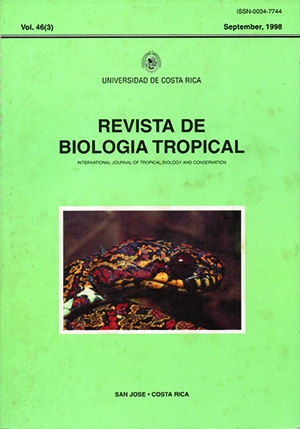Abstract
Mimosa tenuiflora (Willd.) Poir. is an important natural resource in Mexico, due to its diverse uses. However, seed germination, dissemination and seedling establishment of this species had not been studied up to date. Fruits and seeds were collected in the State of Chiapas, Mexico (S. L. Camargo el al. 118, U AMIZ). Germinatíon experiments were carried out afier four years of seed storage; I 935 seeds were sown in Petri dishes containing moistened Wathman filter papero Optimum temperatures were determined in a gradíent 5-40 ° C, with continuous light for mechanically scarified and non scarified seeds. Three photoperiod experiments were made: a) continuous light, b) constant darkness and e) 12 hr lightJ12 hr darkness. Three germinate pretreatments were applied: al meehanical scarification, b) sulfuric acid scarification, el fire scarification and d) control. Three replicates of 15 seeds each were made for each variable and pretreatment. Standard deviations (S) were determined, a one-way analysis of variance ( ANOVAl and media comparison (Scheffé's test) were applied (p<0.05). Analysis of fruit and seed dissemination and seedling establishment was made qualitatively on the basis of field and laboratory observations; radius of dissemination of the fruits from the mother plant was measured; development of laboratory grown seedlings was followed during three months. Seeds germinated al 10- 3(J°C; however, the highest percentages of geCllÚnation were obtained at 200e (84.44%) and 25°C (95.55%); seeds are indistinctIy photoblastic and percentages of germination, afier the three germinate pretreatments, were: control (24.44- 35.55%), mechanical scarification (84.44-88.88%), sulfuric acid searificatÍon (73.33-91.11%) and fire scarification (0% l. Fruits and seeds are disseminated by the wind in a radius of 5-8 m fram the mother plant; rain carrÍes them from slopes to lower plains and human activities contri bu te to their dissemination. Growth of seedlings is fast; they develop a paripinnate protophyll and ten biparipinnate pronomophylls; the first nomophyll develops during the weeks 12 to 14. lt is concluded that optimum temperatures for seed germination of M. tenuiflora are 20 ° C and 2S o C; seeds are indistinctly photoblastic; percentage and rate of germination are highly increased by coat scarification. This species has certain advantages for its establishment in open areas, given by the abundant production of seeds, thelr small size, the rate of germination and Ihe fast growlh, as well as by its seedling characters: the tap root system, the hypocotyl-epicotyl axis woody at the base and, the eompound leaves with Iinear-oblong leaflets having changes in orientation in response to light. Our results confirm the invasive and typically secondary character of this species.
Comments

This work is licensed under a Creative Commons Attribution 4.0 International License.
Copyright (c) 1998 Revista de Biología Tropical
Downloads
Download data is not yet available.






